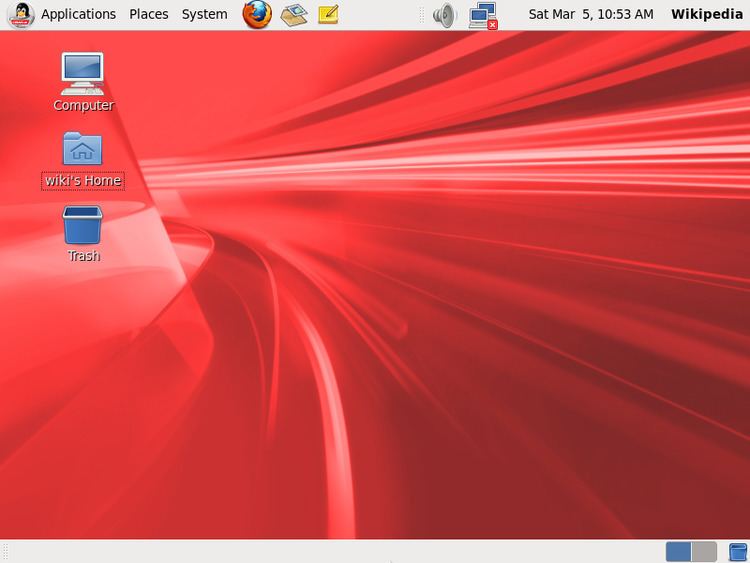Working state Current | ||
 | ||
Initial release 26 October 2006; 10 years ago (2006-10-26) Latest release 7.3 / 10 November 2016; 4 months ago (2016-11-10) | ||
Oracle Linux (OL, is a Linux distribution packaged and freely distributed by Oracle, available under the GNU General Public License since late 2006. It is also used by Oracle Cloud and Oracle Engineered Systems such as Oracle Exadata and others.
Contents
- RHEL compatibility
- Hardware compatibility
- Virtualization support
- Deployment inside Oracle Corporation
- Related products
- Specific additions
- Sun Fire systems
- Cisco UCS systems
- Future SPARC version
- Software updates and version history
- Release history
- Oracle OpenStack for Oracle Linux
- References
Potential users can freely download Oracle Linux through Oracle's E-delivery service (Oracle Software Delivery Cloud) or from a variety of mirror sites, and can deploy and distribute it without cost. Oracle's Oracle Linux Support program provides commercial technical support, covering Oracle Linux and existing RHEL or CentOS installations (i.e. without re-installation or re-boot). As of 2016 Oracle Linux had over 15,000 customers subscribed to the support program.
RHEL compatibility
Oracle Corporation distributes Oracle Linux with two alternative kernels:
Oracle claims that the Unbreakable Enterprise Kernel is compatible with RHEL, and that Oracle middleware and third-party RHEL-certified applications can install and run unchanged on the Unbreakable Enterprise Kernel. For users requiring strict compatibility with Red Hat or for users running kernel modules dependent on specific kernel versions, the Red Hat Compatible Kernel offers 100% compatibility with Red Hat Enterprise Linux.
Hardware compatibility
Oracle Linux is certified on servers including from IBM, Hewlett-Packard, Dell, Lenovo, and Cisco. In 2010, Force10 announced support for Oracle VM Server for x86 and Oracle Linux. Oracle Linux is also available on Amazon EC2 as an Amazon Machine Image, and on Microsoft Windows Azure as a VM Image.
Oracle/Sun servers with x86-64 processors can be configured to ship with Oracle Linux.
Visit the Hardware Certification List for the complete list of the certified hardware on Oracle Linux and Oracle VM.
Virtualization support
Under the Oracle Linux Support program, Oracle Linux supports KVM and Xen.
Other Oracle products are only supported under the Xen-based Oracle VM Server for x86.
Deployment inside Oracle Corporation
Oracle Corporation uses Oracle Linux extensively within Oracle Public Cloud, internally to lower IT costs. Oracle Linux is deployed on more than 42,000 servers by Oracle Global IT; the SaaS Oracle On Demand service, Oracle University, and Oracle's technology demo systems also run Oracle Linux.
Software developers at Oracle develop Oracle Database, Fusion Middleware, E-Business Suite and other components of Oracle Applications on Oracle Linux.
Related products
Oracle Linux is used as the underlying operating system for the following appliances.
Specific additions
Sun Fire systems
In March 2012, Oracle submitted a TPC-C benchmark result using a Sun Fire server running Oracle Linux and Unbreakable Enterprise Kernel. With 8 Intel Xeon processors running Oracle DB 11 R2, the system is able to handle over 5.06 million tpmC (New-Order transactions per minute while fulfilling TPC-C). The server is the third fastest TPC-C non-clustered system and is the fastest x86-64 non-clustered system.
Oracle also submitted a SPECjEnterprise2010 benchmark record using Oracle Linux and Oracle WebLogic Server, and achieved both a single node and an x86 world record result of 27,150 EjOPS (SPECjEnterprise Operation/second).
Cisco UCS systems
Cisco submitted 2 TPC-C benchmark results that run Oracle Linux with the Unbreakable Enterprise Kernel R2 on UCS systems. The UCS systems rank fourth and eighth on the top TPC-C non-clustered list.
Future SPARC version
In December 2010, Oracle CEO Larry Ellison, in response to a question on Oracle's Linux strategy, said that at some point in the future Oracle Linux would run on Oracle's SPARC platforms.
At Oracle OpenWorld 2014 John Fowler, Oracle's Executive Vice President for Systems, also said that Linux will be able to run on SPARC at some point.
In October 2015, Oracle released a Linux reference platform for SPARC systems based on Red Hat Enterprise Linux 6.
In September 2016, Oracle released information about an upcoming product, Oracle Exadata SL6-2, a database SPARC T7-2 servers running SPARC Linux.
Software updates and version history
In March 2012, Oracle announced free software updates and errata for Oracle Linux on Oracle's public yum repositories. In September 2013, Oracle announced that each month its free public yum servers handle 80 TB of data, and the switch to the Akamai content delivery network to handle the traffic growth.
Release history
Oracle Linux uses a version-naming convention identical to that of Red Hat Enterprise Linux (e.g. the first version, Oracle Linux 4.5, is based on RHEL 4.5).
Oracle OpenStack for Oracle Linux
Oracle announced on 24 September 2014 Oracle OpenStack for Oracle Linux distribution which allows users to control Oracle Linux and Oracle VM through OpenStack in production environments. Based on the OpenStack Icehouse release, Oracle OpenStack for Oracle Linux distribution is a cloud management software product that provides an enterprise type solution to deploy and manage the IT environment. The product maintains the flexibility of OpenStack, allowing users to deploy different configurations, and to integrate with different software and hardware vendors. Oracle OpenStack for Oracle Linux is available for free download. There is no licensing cost. It can be downloaded for free from the Oracle web page. Supported OpenStack Services in Version 1 includes Nova, Keystone, Cinder, Glance, Neutron, Horizon and Swift. According to Oracle the support for Oracle OpenStack for Oracle Linux is included as part of Oracle Premier Support for Oracle Linux, Oracle VM, and Systems. Oracle OpenStack for Oracle Linux can be downloaded from this site.
